Nationally Designated Important Cultural Property
Arakawa Residence Visit
Apr. May Jun. Jul. Aug. Sep. Oct. Nov. Dec. 2021 Inf.
May
May 20th: Hearth
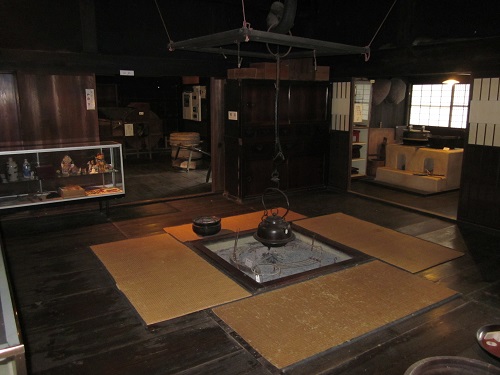 There is a hearth (Irori) in living room (Hinata).
A pothook (Kagizuru) is hung above the hearth.
It had an iron kettle (Tetsubin) on it.
The hearth was the center of the family, and it was a room of the family
to eat and to the family.
There is a hearth (Irori) in living room (Hinata).
A pothook (Kagizuru) is hung above the hearth.
It had an iron kettle (Tetsubin) on it.
The hearth was the center of the family, and it was a room of the family
to eat and to the family.
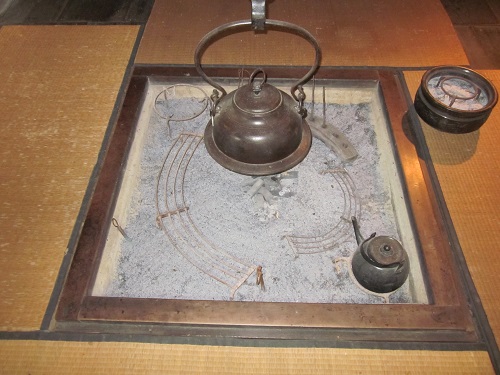 Ash was laid on the hearth (Irori) , and a trivet (Gotoku),
fire chopsticks (Hibashi), iron kettles (Tetsubin), etc. were placed.
Ash was laid on the hearth (Irori) , and a trivet (Gotoku),
fire chopsticks (Hibashi), iron kettles (Tetsubin), etc. were placed.
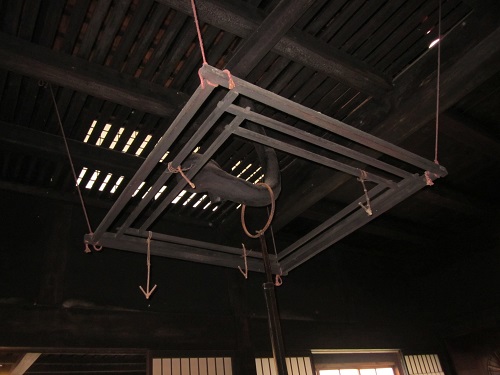 At the top of the hearth (Irori), a large wooden hook is hung from the ceiling,
and a pothook (Kagizuru) hangs on it.
The fire shelve (Hidana) and ceiling are blackened by the smoke of the bonfire.
At the top of the hearth (Irori), a large wooden hook is hung from the ceiling,
and a pothook (Kagizuru) hangs on it.
The fire shelve (Hidana) and ceiling are blackened by the smoke of the bonfire.
The ceiling is a slatted wood ceiling where smoke in the hearth is easy to pass.
Wood such as columns, beams, and girders have a longer life of
the building due to the antiseptic and insect repellent effects of smoke.
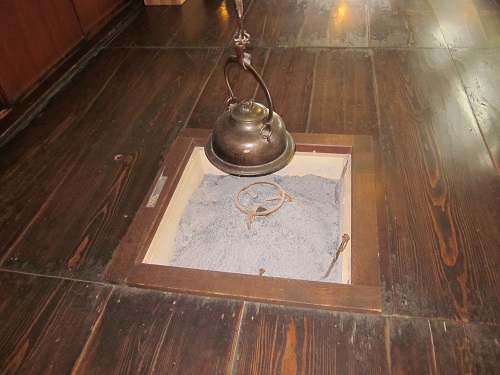 There is a small hearth (Irori) in Oue (one room from the doorway).
A pothook (Kagizuru) is hung above the hearth.
It had an iron kettle (Tetsubin) on it.
There is a small hearth (Irori) in Oue (one room from the doorway).
A pothook (Kagizuru) is hung above the hearth.
It had an iron kettle (Tetsubin) on it.
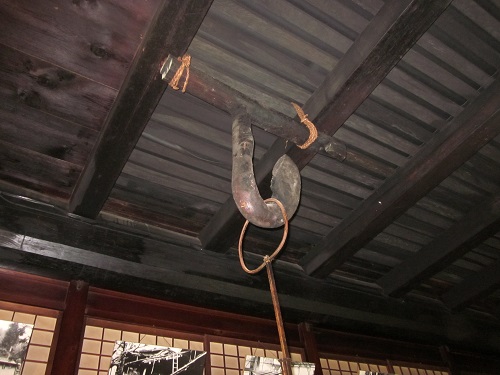 At the top of the hearth (Irori), a square timber is tied to the ceiling
with a rope.
It has a big wooden hook attached to it, and a pothook (Kagizuru) hangs on it.
At the top of the hearth (Irori), a square timber is tied to the ceiling
with a rope.
It has a big wooden hook attached to it, and a pothook (Kagizuru) hangs on it.
The ceiling is a slatted wood ceiling where smoke in the hearth is easy to pass.
The ceiling are blackened by the smoke of the bonfire.
May 20th: Rice Polishing Hut (Tsukiya)
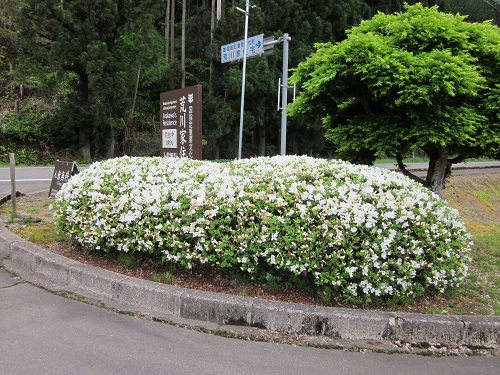 The white flower azaleas next to the entrance of the Arakawa Residence were
in full bloom.
The white flower azaleas next to the entrance of the Arakawa Residence were
in full bloom.
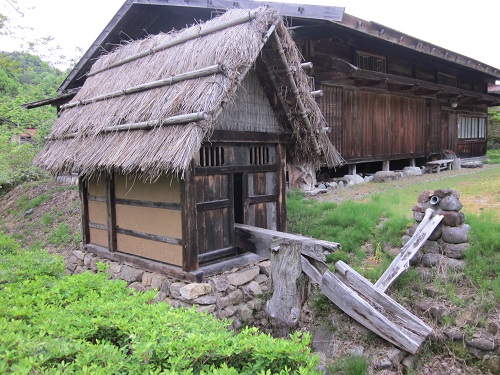 This thatched roof hut is a Rice Polishing Hut (Tsukiya),
which has the width is 1.5 ken (2.7 m) and the depth is 1 ken (1.8 m).
This thatched roof hut is a Rice Polishing Hut (Tsukiya),
which has the width is 1.5 ken (2.7 m) and the depth is 1 ken (1.8 m).
The Rice Polishing Hut (Tsukiya) is a hut built to use water to polish rice.
SouzuKarausu for polishing rice is installed from the inside to
the outside of the Rice Polishing Hut (Tsukiya).
It is built near the brook between the Arakawa Residence and the Ogata house.
(Souzu: water-filled bamboo tube in Japanese garden which clacks against
a stone when emptied; Karausu: mortar)
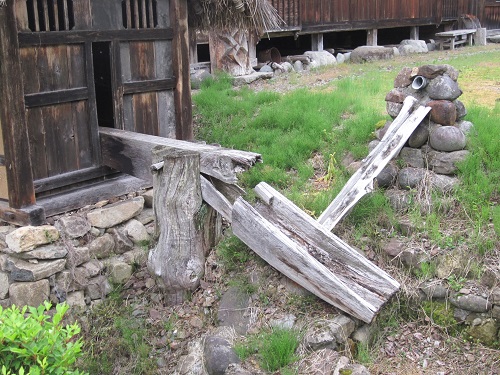 SouzuKarausu for polishing rice is coming out from the inside to
the outside of the Rice Polishing Hut (Tsukiya).
SouzuKarausu for polishing rice is coming out from the inside to
the outside of the Rice Polishing Hut (Tsukiya).
SouzuKarausu has a stone mortar on the floor inside Tsukiya,
and a pestle stick out from a square lumber on it.
The square lumber goes out of Tsukiya and is rsupported by a large support.
Beyond that is a rectangular water bowl that stores water.
(It was broken now, and it bent from the support and the tip was touched
to the ground.)
Above the water bowl is the end of the gutter that drains water.
(This was also broken, and the end was touched the ground.)
In the movement of the SouzuKarausu, water first falls from the end
of the gutter and the water is stored in the water bowl.
When the water is full, the water bowl side becomes heavy and lowers,
and the pestle side lifts up like a seesaw.
Then, the water bowl tilts, so the water spills.
So the water bowl side becomes lighter, it lifts up and the pestle
falls on the stone mortar.
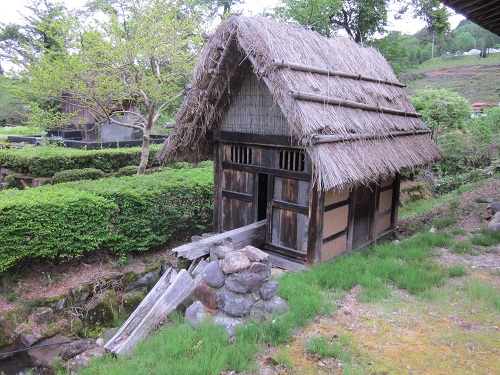 The entrance to the sliding door is on the right side of the
Rice Polishing Hut (Tsukiya)
The entrance to the sliding door is on the right side of the
Rice Polishing Hut (Tsukiya)
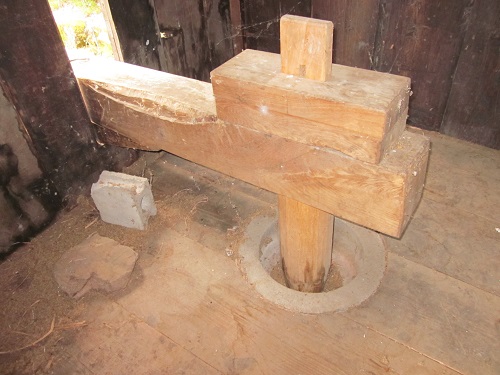 Inside the Rice Polishing Hut (Tsukiya),
there is a stone mortar, and a pestle stick out from square wood.
Inside the Rice Polishing Hut (Tsukiya),
there is a stone mortar, and a pestle stick out from square wood.
Brown rice is put in the stone mortar, rice is polished,
and bran is taken and it becomes white rice.
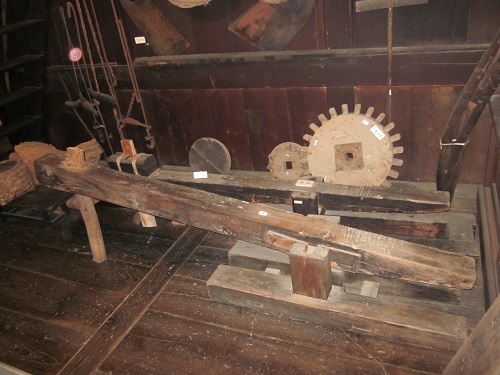 There is a mortar (Karaus) in the workshop (Niwa).
There is a mortar (Karaus) in the workshop (Niwa).
(The one on the other side was originally here.
The one in the foreground was brought from another place
and there is no stone mortar.)
There is a support on the base and the square lumber is supported by the
support shaft. (Length: 2m43cm)
A pestle is attached to the square lumber at the left tip part.
A stone mortar is installed under it.
(Diameter: 36 cm, depth: 26 cm)
How to use, a person steps on the right end with his foot and pushes it down.
The side of the pestle is lifted like a seesaw, and when you remove your foot,
the pestle falls on the stone mortar.
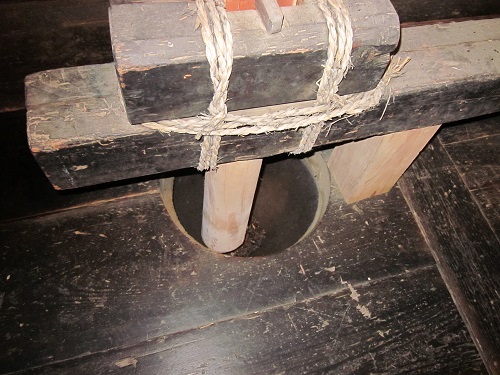 In the stone mortar part, there is a stone mortar, and a pestle attached to
the square lumber.
In the stone mortar part, there is a stone mortar, and a pestle attached to
the square lumber.
Brown rice is put in the stone mortar, rice is polished,
and bran is taken and it becomes white rice.
The stone mortar is under the floor, and when not in use, lid it with the
same thickness as the thick floorboard.
(The round plate that stands against the wall on the other side
of the photo above is the lid.)
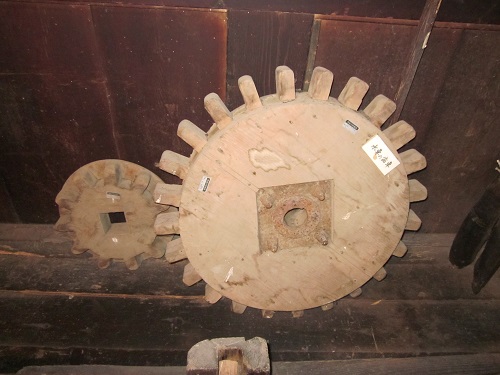 The gears of large and small wood mounted on the wall are mounted on
the shaft in the water mill to transmit rotation.
The gears of large and small wood mounted on the wall are mounted on
the shaft in the water mill to transmit rotation.
A water wheel require a considerable amount of water,
but Tsukiya's SouzuKarausu can be used
in places where the amount of water is small.
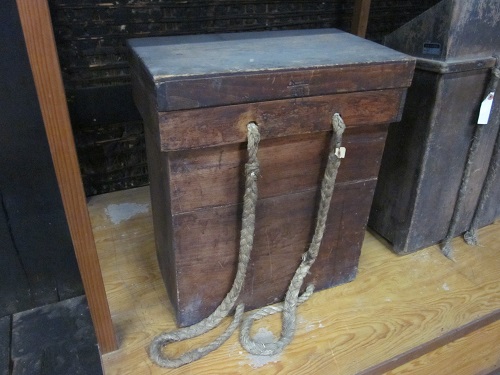 This is a TsukiyaBako (box) for carrying brown rice to
Rice Polishing Hut (Tsukiya).
Brown rice was put in this tsukiyabaco, it carried it on the back,
and it carried it to tsukiya.
This is a TsukiyaBako (box) for carrying brown rice to
Rice Polishing Hut (Tsukiya).
Brown rice was put in this tsukiyabaco, it carried it on the back,
and it carried it to tsukiya.
May 15th: Wooden Board Roof (Kurebuki)
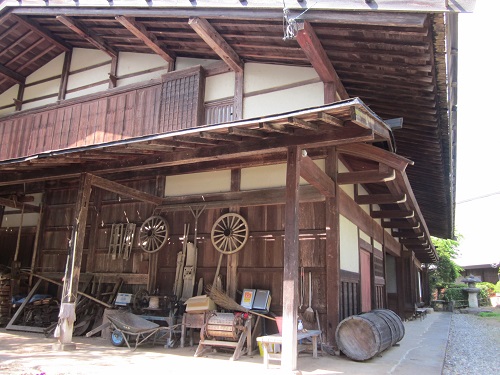 The Main House is a large house with a two-story gable structure,
the width is 11 ken (20 m) and the depth is 8 ken (14.5 m).
The Main House is a large house with a two-story gable structure,
the width is 11 ken (20 m) and the depth is 8 ken (14.5 m).
(For details, please refer to "Information")
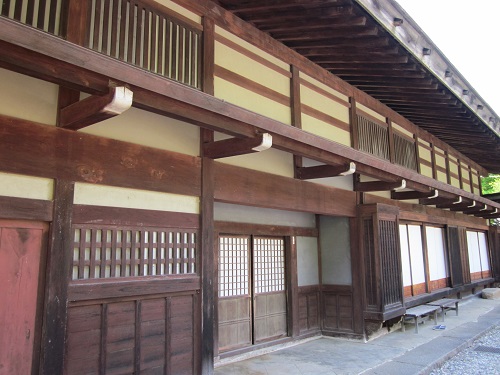 There is a small eave in front of the it.
The outside girder (Dashigeta) is placed on the bracket (Udegi) from the pillar,
and it supports the small eaves.
There is a small eave in front of the it.
The outside girder (Dashigeta) is placed on the bracket (Udegi) from the pillar,
and it supports the small eaves.
Large wood is used for pole plate (Nokigeta).
On the 2nd floor,There is a lattice window and a two-tiered crosspiece ( Nuki ).
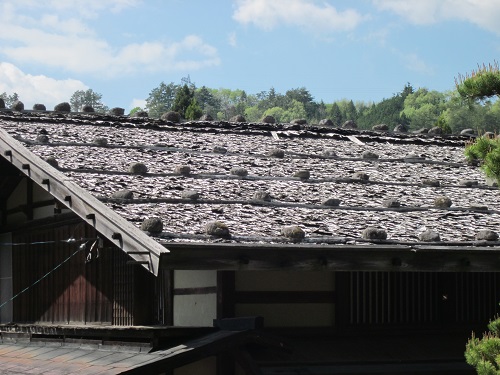 The roof is made of wooden board ((Kurebuki)),
which is held down with logs so that it is not blown away by the wind,
and heavy stones are placed on it.
The slope of the roof is gentle (32/100) to prevent stones from rolling down.
The roof is made of wooden board ((Kurebuki)),
which is held down with logs so that it is not blown away by the wind,
and heavy stones are placed on it.
The slope of the roof is gentle (32/100) to prevent stones from rolling down.
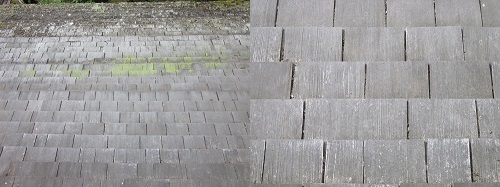 This is a Wooden board (Krebuki) seen from the top (2nd floor) of the appentice
(Sashikakeyane).
It was beautifully covered.
This is a Wooden board (Krebuki) seen from the top (2nd floor) of the appentice
(Sashikakeyane).
It was beautifully covered.
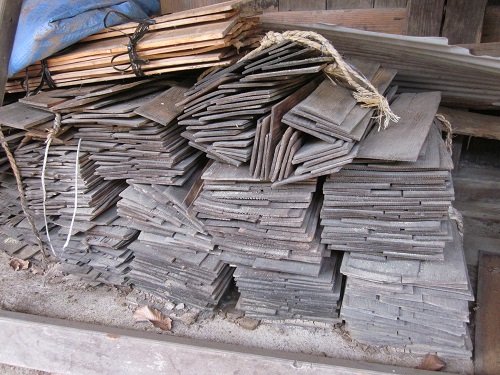 There are bunches of wooden boards (Kure) of roof material.
The size of one piece was 45 cm long, 6 to 20 cm wide, and 5 to 7 mm thick.
There are bunches of wooden boards (Kure) of roof material.
The size of one piece was 45 cm long, 6 to 20 cm wide, and 5 to 7 mm thick.
The wooden board (Kure) is made of thinly peeling off wood such as chestnut trees.
The roof of wooden board (Kure) is damaged by wind and rain for many years,
so replace the damaged part and repair it.
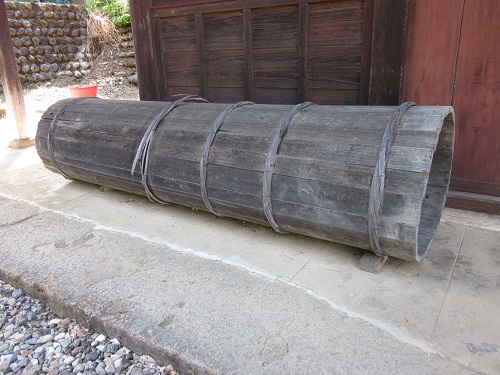 This tub is a hemp-steamed tub.
This tub is a hemp-steamed tub.
(Length: 2m70cm, upper outer diameter: 80cm, bottom outer diameter:
60cm, plate thickness: 2.5cm)
The stalk part of the hemp cut is put in this tub, it is placed upside down
on a large kettle, and it steams.
After steaming, peel off the bark.
Hemp thread is made from the fibers of the bark,
and woven with a weaving machine to make hemp cloth.
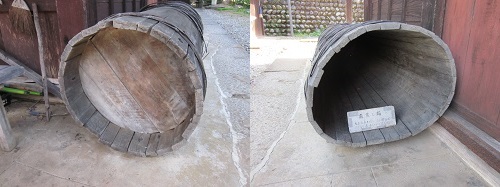 Left: I saw the hemp-steamed tub from the bottom side.
Left: I saw the hemp-steamed tub from the bottom side.
Right: I saw the hemp-steamed tub from the upper side.
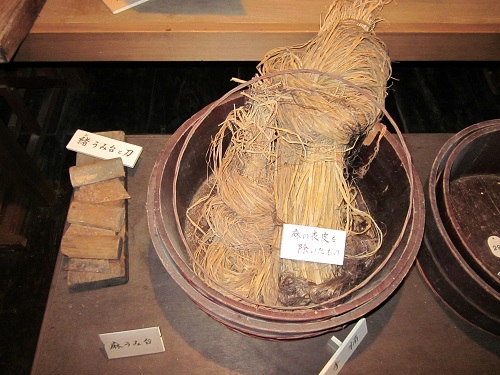 This is the hemp (in the tub) excluding the bark of hemp,
and the hemp stand and the blade.
This is the hemp (in the tub) excluding the bark of hemp,
and the hemp stand and the blade.
May 7: Farm Tools to Cultivate Rice Fields
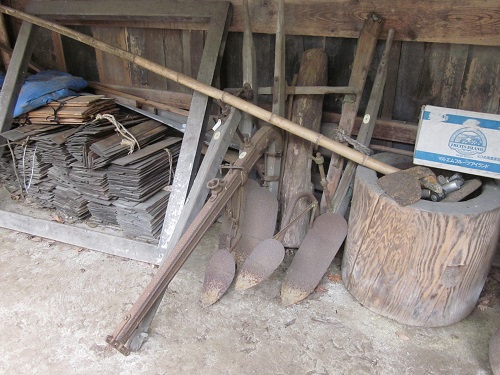 To cultivate rice fields, we used livestock power (horses, cattle) or
human power.
To cultivate rice fields, we used livestock power (horses, cattle) or
human power.
(Central part): They are plow (Suki) that is pulled by horses and cattle
to plow rice fields. (3 units overlap)
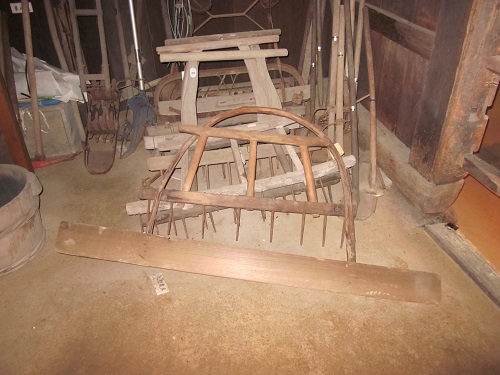 They are harrows (Manga) that is pulled by horses and cattle to puddling
(Shirokaki).
(5 units overlap)
They are harrows (Manga) that is pulled by horses and cattle to puddling
(Shirokaki).
(5 units overlap)
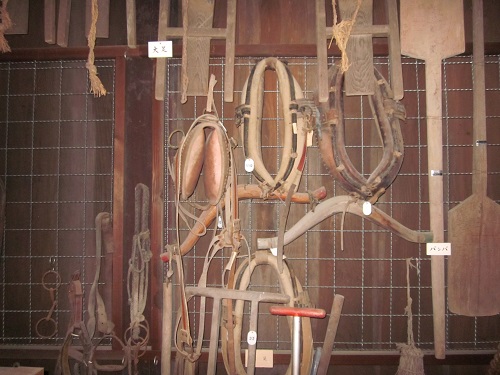 They are equipment to attach to a horses or cattle.
They are equipment to attach to a horses or cattle.
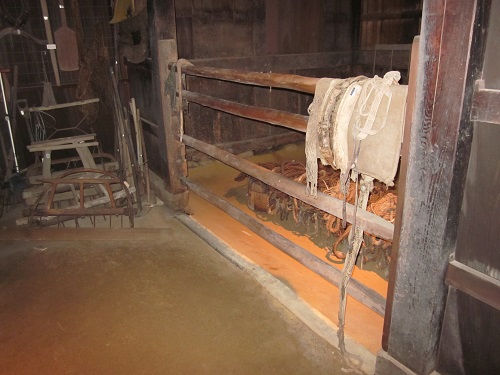 There is a stable called Maya inside the house.
In the farmers, horses and cattle are valued,
and they were bred together in the main house.
There is a stable called Maya inside the house.
In the farmers, horses and cattle are valued,
and they were bred together in the main house.
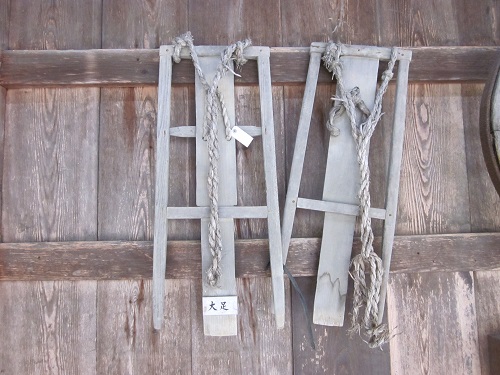 Since the rice field after puddling (Shirokaki) with a hoe (kuwa) is bumpy,
it is Oashi for stepping on the soil and rice stocks from the
surface of the rice field and flattening it.
Since the rice field after puddling (Shirokaki) with a hoe (kuwa) is bumpy,
it is Oashi for stepping on the soil and rice stocks from the
surface of the rice field and flattening it.
(Length: 80 cm, width: 35 cm)
People put it on their feet and went around the rice field evenly.
There was the ropes in the front of the Oashi,
and the rope of the foot which stepped on was pulled by the hand,
and the front side was lifted and it advanced.
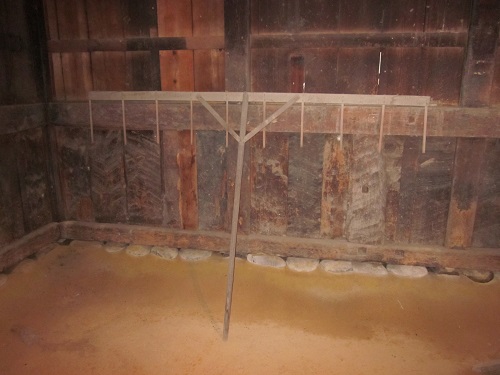 When planting rice, it is a line drawing (Sujihiki) that draws a line
before planting by hand.
Seedlings are planted on the lines drawn to the rice field.
When planting rice, it is a line drawing (Sujihiki) that draws a line
before planting by hand.
Seedlings are planted on the lines drawn to the rice field.
Back
<< Home < Back Next >